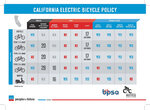Phil Agur
Member
I'm opposed to the eBikes laws currently adopted in California.
The dealers are pretty happy with all classes of product being defined as up to 750 watts. That makes it easy to reconfigure inventory on the fly to be a type 1, 2, or 3 but it doesn't serve the cycling community well at all. I want the type 1 definition taken down in both power and speed so a pedal-assist only eBike only performs in a humanly possible manner. Even professional team cyclists can't sustain 750 watts for very long.
I recently watched a GCN challenge video showing a monumental climb road bike vs Mountain eBike. It was not a fair comparison at all but the road bike was equipped with power meters giving insight into what fit humans can actually do.
The road rider was looking to produce just over 250 watts and commented about being drained pushing 287 watts. Leave the type 2 and type 3 alone serving utility and commuter markets but let's get a little daylight in the sport cyclist spec. If 287 watts will climb the Col De La Madone then 250 watts of boost is huge in a pedal-assist only format eBike. We want eBikes that are light well-performing bicycles first with an efficient very moderate boost motor that cuts off boost at bike trail speed limits or just below. Let's give lightweight, 250-watt, long-range type 1 eBikes room to breath.
The dealers are pretty happy with all classes of product being defined as up to 750 watts. That makes it easy to reconfigure inventory on the fly to be a type 1, 2, or 3 but it doesn't serve the cycling community well at all. I want the type 1 definition taken down in both power and speed so a pedal-assist only eBike only performs in a humanly possible manner. Even professional team cyclists can't sustain 750 watts for very long.
I recently watched a GCN challenge video showing a monumental climb road bike vs Mountain eBike. It was not a fair comparison at all but the road bike was equipped with power meters giving insight into what fit humans can actually do.
